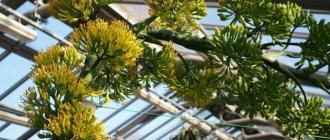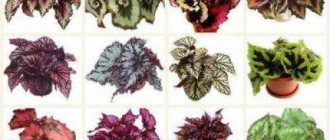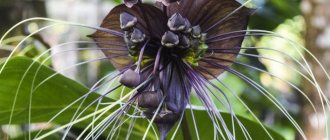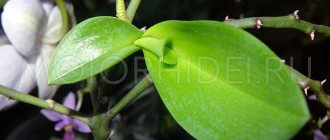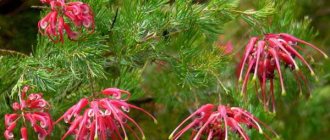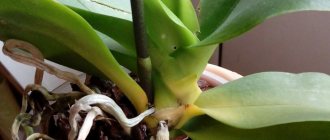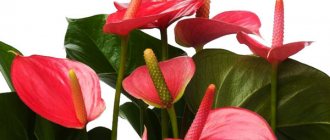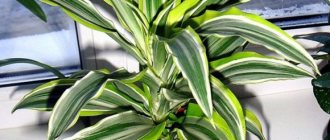Among lovers of indoor flowers, dracaena (from the Latin Dracaena), which is also called the false palm, is very popular. About 150 species of this plant are known in nature. It not only pleases the eye at home or in the office, but also enriches the air with oxygen. Proper care and timely recognition of diseases guarantee a long life for the flower. Yellowing and falling leaves is a serious signal to think about finding the cause that caused such symptoms. Below we explain why dracaena leaves fall off and what to do to save the flower.
Dracaena leaves fall: what could be the reasons?
This is an unpretentious indoor plant that does not require special care. But if the leaves begin to fall, this may indicate non-compliance with care recommendations.
A wilting palm tree urgently needs to be saved
For your information! The life cycle of dracaena leaves is two years. Therefore, it tends to shed its leaves. However, massive loss will result in the death of the flower.
The main reasons for leaf fall:
- watering. Untimely watering will cause the soil to dry out. As a result, the leaves will begin to dry out, and their fall is inevitable. Excessive moistening of the substrate also negatively affects the plant, since the trunk becomes soft from the abundance of water, the leaves begin to wither and fall off;
- spraying. This procedure, if simple rules are not followed, also has a detrimental effect on indoor flowers. Stagnation of liquid in the leaf sinuses provokes rotting. Dracaena will begin to shed some of its foliage;
- fertilizer. If the leaves of the dracaena die, this means that feeding is carried out incorrectly. It is important to comply with all conditions for preparing fertilizer, doses and application rules;
- root damage during transplantation. The dracaena is transplanted into a new pot as its growth increases. During this procedure, the root system can be damaged. Therefore, in response to a stressful situation, the plant sheds its leaves;
- incorrect microclimatic conditions. There are many of them: lack or excess of light, drafts, unsuitable temperature and humidity;
- diseases and insect pests. Failure to follow the rules of care leads to weakened immunity. The plant is attacked by pathogens or insects.
Note! The flower does not tolerate drafts and direct sunlight. These two factors cause the leaf blade to dry out at the edges, turn yellow and fall off.
To answer the question of how to save dracaena, you need to find out the reason that provokes the death of the plant.
Dracaena at home - Best design ideas and location tips! (83 photos)
Dracaena belongs to plants that grow in the humid tropics. It grows like a shrub, but has one trunk reaching 20 meters in height.
About 40 varieties of dracaena are grown at home, among which the most common are: Fragrant dracaena, Dracaena Marginata and Dracaena Gosdefa.
Dracaena Marginata is usually grown in spacious rooms, because under favorable conditions it can reach 3 meters in height.
In small rooms you can find decorative dracaena Sander, which can grow independently, or several dracaenas of this variety can grow in one pot at once, creating an original composition of intertwined trunks.
However, no matter what variety of dracaena you choose, only a healthy flower can be beautiful. That is why it is very important to properly care for indoor flowers. Having decided to buy dracaena, you first need to find out in what conditions it should be kept.
Dracaena care
The most important thing in caring for a plant such as dracaena is maintaining the watering regime. However, there are other requirements for caring for dracaena, so it is necessary to maintain a certain temperature regime, you need to arrange the lighting correctly and fertilize it in a timely manner.
In summer, dracaena will be comfortable at 18-22 C. In addition, this flower feels great on an open balcony.
As for lighting, dracaena does not tolerate direct sunlight, but the room where this plant is located should be well lit.
If the plant grows in a pot, then it is preferable that the pot be placed on a stand, which would be located at a distance of 1.5 meters from the window, so that in the heat the sun will not burn the leaves and the dracaena will receive a sufficient amount of light. If you notice dark dots on the leaves, then these are traces of sunburn.
In case of insufficient lighting, the problem can be solved with the help of artificial lighting, otherwise the leaves of the plant will be faded and weak.
In the summer, feed dracaena once a week, and in winter no more than once every 30 days.
Dracaena loves fresh air, but does not tolerate drafts.
An adult plant must be regularly replanted into a larger pot. Dracaena that has reached a height of 40 cm requires a container whose diameter should be 15 cm.
The young seedling must be replanted every year in the spring, using soil intended for palm trees.
No less important than lighting and temperature for dracaena is the creation of a favorable tropical microclimate.
Rules for moisturizing dracaena
The higher the temperature in the room, the more humid the plant should be. Humidity increases due to evaporation. So, you can place an aquarium with fish near the flower, and you can also moisten the dracaena by spraying.
In summer, the plant needs to be watered as soon as the soil dries out a little. In the hot season, dracaena needs to be watered abundantly. But in winter, watering is reduced, so that the roots of the flower do not rot, you need to let the soil dry for 7 days.
Water for irrigation can only be used filtered.
What needs to be done for dracaena to bloom
If you meet all the conditions for caring for dracaena, the plant will definitely bloom. The most fragrant variety of flower is the fragrant dracaena.
The buds of this flower ripen within a year, and sometimes longer. And a variety such as edged dracaena can bloom only after reaching the age of 12 years, but the wait is worth it, in addition to beautiful buds you will receive a delightful aroma, somewhat reminiscent of the smell of honey.
How to get rid of diseases and pests
The main enemy of dracaena is scale insects. The presence of this pest can completely destroy the plant.
The speed of spread of the scale insect is simply amazing, so if measures are not taken immediately, this will lead to the death of the flower. At the initial stage, when the number of pests is still small, you can simply wash the plant with a soapy solution and vodka.
And if the number of pests is large, then it is better to use a special product - Actellik.
Another pest of dracaena is the mealybug, which is removed by thoroughly washing the flower with a soap solution.
You should also avoid drying out the soil and drafts, which can cause the plant to get sick, which will immediately affect its leaves. The main sign of dry soil is darkened leaves.
In addition, excessive watering can lead to rotting of the root system and death of the plant.
Dracaena is dying: how to save it from the disease
Why do dracaena leaves turn yellow - reasons
If all maintenance conditions are observed, the development of diseases and leaf fall can be avoided. The plant will have strong immunity and will be able to overcome the disease. In addition, it is recommended to periodically add fertilizers that contain phosphorus and potassium to the soil.
However, it is not always possible to protect the flower from infection. Signs of the disease most often appear on the foliage. First of all, the color of the leaf blade changes, turgor is lost, spots appear, the tips dry out, and then their base.
Dracaena has many diseases
Diseases that most often affect dracaena:
- heterosporosis. The foliage on both sides begins to turn yellow, then becomes spotted and dries. Without treatment, the flower dies. To help the plant, you need to react in time. Fungicides that contain copper can help;
- phyllosticosis. Brown spots of irregular shape with a green or yellow border appear on the foliage of the lower tier. They are quite large in size. Leaves may fall;
- bacteriosis The foliage at the tips rots, so the plant sheds it en masse. Cankers may be seen on the stem. High humidity and high room temperature are the main factors in the development of the disease. Treatment is useless, so the flower will have to be destroyed to save the rest of the plants in the house;
- Alternaria blight. A fungal disease, the signs of which are brown spots. Over time, without treatment, they begin to turn black. Three times a month should be sprayed with fungicides. This will help fight and prevent the disease.
Why does dracaena shed its leaves en masse when it gets sick? This is a natural response to pathogens. This is how the plant tries to protect other organs.
For your information! Fungicidal preparations such as quadris, topaz, and maxim will help combat diseases.
Pests
Why ficus leaves fall - reasons
Pests are often found on the soil or enter the plant from neighboring infected indoor flowers. Sticky plaque, the appearance of cobwebs and spots on foliage become the main signals of an invasion. If dracaena begins to dry out, what to do about this problem and how to overcome pests?
Who to watch out for:
- scale insect This insect is about 3-4 mm in size, practically motionless and protected by a grayish waxy shell. It sucks juices from leaves and stems, causing them to dry out and fall off;
- thrips. Whole columns settle on the lower part of the leaf. The upper part becomes spotted and darkens;
- spider mite A small pest that is difficult to notice. Settles on the lower part of the leaf blade. The main signs of its invasion are the appearance of cobwebs and white plaque. Fall of leaves is inevitable;
- Mealybugs. The juice is sucked out of the plant, this stops the development and growth of the flower. A white waxy coating resembling cotton wool is left on the leaves and rosettes.
Pests on foliage are visible to the naked eye
It is recommended to observe the watering regime, temperature conditions and use insecticidal preparations. They often resort to the help of such drugs as actara, karbofos, and intavir.
Mistakes when growing dracaena
There are several common mistakes that are made when growing a dragon tree. The plant will definitely “let you know” that it has not been properly cared for. By its appearance you can determine what went wrong. The most common errors and their symptoms:
Cramped pot.
If the dracaena is in a pot for a long time without replanting, then the soil is gradually depleted. The flower begins to experience a nutritional deficiency. In addition, the roots occupied the entire space of the container so much that they began to grow out of the drainage holes. All these signs indicate that the flowerpot has become too small. The plant lacks vital macro- and microelements, it gradually withers and dies.
Excessive amount of moisture.
Dracaena will respond to overwatering by wilting and yellowing of the leaves. In this case, it is necessary to immediately transplant it into new soil in order to protect it from imminent death.
Prolonged drying of the soil.
When a plant lacks moisture for a long time, it also changes its appearance. The leaves begin to wither, become soft, dry out and fall off. The fact is that plant tissues lose turgor - internal hydrostatic pressure in the cells. And as a result, first the dracaena withers and then dies.
Pests.
External signs of such a problem are easy to identify. On the leaves and soil you can easily notice dracaena pests - whiteflies, mealybugs, scale insects, and herbivorous mites. If they have settled on a plant, then it also needs to be urgently replanted. In this case, the dracaena is treated with acaricidal and insecticidal preparations, and the soil is completely changed.
Advice.
After purchasing dracaena, it must be treated with special preparations. This is done to protect your other houseplants from pests that may be introduced along with the new bush. Do not forget also that the purchased flower is in a small pot. It contains a limited amount of substrate and will not provide enough “feeding” for the seedling for a long time. Therefore, try not to delay too much when transplanting a new plant into a pot with fresh soil.
Soil moisture
Why do dracaena leaves droop?
Dracaena loves moderately moist soil. There is no need to flood it, as the stem and roots may eventually begin to rot. This will cause the plant to begin to die before our eyes.
In the hot season, it is recommended to water the flower once every 2-3 days. You must always navigate the soil in the pot. If the soil at the base of the stem has dried out, then it needs to be moistened. It will be enough to pour in 170-200 ml of settled water at room temperature.
Proper watering will be a good preventative measure against leaf fall.
Winter is the flower's rest period. It needs watering only once every 4-6 days. And if dracaena begins to fade, what to do during this period? Again, you need to navigate along the dried soil. This is the only way to understand whether a plant needs water.
Important! If the flower pot is on the windowsill above the radiator, then the soil moisture will have to be increased a little more often.
Which pot is suitable for transplanting dracaena?
A pot with a small bottom and a wide top, similar in shape to a truncated cone, is best suited. the material can be different: plastic, clay, ceramics. But there must be at least one, or preferably several, drainage holes at the bottom. They are needed to remove excess moisture outside. The soil will not be waterlogged, which means the roots will not rot. Pay attention to the pallet. It should have high sides so that accumulated water can be easily drained.
Pots with an automatic watering system are also a good option. Although the most ordinary pot will do just fine. The main criterion for choosing a container is that the diameter of the new pot should be 5-6 cm larger than the new one.
Air temperature
If the basic rules of the microclimate are not observed, the leaves of the flower begin to fall off. What to do in such cases? At home, the temperature regime is very important for the flower. In summer, to ensure good growth and development, you need to keep the mark on the thermometer within 24-32 °C. During the cold season, the room temperature should not be allowed to fall below 17 °C.
A temperature of 12 °C can become critical for death. Then the first thing the plant will do is shed all its foliage, and then it will begin to slowly die.
Dracaena transplant
Having chosen a suitable pot, you can begin replanting. It is carried out this way:
1. Remove the plant from the pot.
Inspect the root system. If it is healthy, then all you need to do is move the dracaena to a new container and add fresh substrate. Are there any rot or blackening on the roots? Then remove the old soil, and cut off the diseased and damaged roots with a disinfected knife, blade or scissors. Treat the root system by immersing it for several minutes in a weak water solution of potassium permanganate.
2. Lay a drainage layer.
Fill the bottom of the pot with any drainage material - expanded clay, fine gravel, crushed stone. This layer will prevent the roots from coming into contact with stagnant water after watering.
3. Fill the pot 1/3 full with soil.
For dracaena, select soil with a neutral or slightly acidic reaction. Choose a universal flower soil for planting. You can also use a special substrate for dracaenas or palm plants. Add vermiculite, perlite, diatomaceous earth or ground charcoal to the soil. Such impurities improve the growth and development of dracaena.
4. Move the dracaena.
Carefully place the plant in the center of the pot. Make sure that the root collar does not go deep underground. Severe deepening during planting can lead to rotting of the stem. Place the dracaena at the same level as in the previous pot. Then fill the root system with soil, leaving no voids. Lightly compact the soil.
Remove the dracaena from the pot and inspect the root system
Prepare a pot for replanting and move the dracaena into it
Cover the dracaena with soil and water it.
To make the dracaena better take root in a new place, water it with water containing any preparation that stimulates root growth. “Kornevin” and “Heteroauxin” are well suited for these purposes. If after watering you notice that the soil has sagged and the ground level has become lower, then add a little more substrate on top.
Root rotting
There are many reasons why dracaena leaves fall. One of them is often root rotting. Excessive watering, especially during the dormant period (winter), can be the death of a false palm tree.
Important! If the soil has not dried to a depth of 2 cm, there is no need to water.
Rotting of the root system leads to disruption of the transport of water and nutrients to other organs. Dracaena first gets rid of old leaves, and then the young ones fall off.
Root rotting
Other Possible Problems
In addition to all of the above, there are other reasons why dracaena may begin to shed its leaves and soon die (if measures are not taken in time).
Among them:
- transfer. When the root system is actively growing and the flower increases in size, it needs a larger pot. You need to replant carefully, otherwise you may damage the root or stem. The stress that a flower receives while adapting to a new place can lead to the loss of foliage;
- direct sunlight. It is important to choose the right place in the house where the pot with dracaena will be placed. It does not tolerate direct sunlight: it begins to dry out and the leaves turn yellow. It even happens that the stem, when drying out, can fold in half. The plant sheds its leaves and dies;
- drafts. Dracaena does not like drafts, so a window sill is not the best place for a palm tree. Firstly, in such places the temperature fluctuations are caused by the battery, and secondly, frequent ventilation using an open window will provide unfavorable conditions for the delicate flower;
- fertilizers Excess or lack of fertilizing leads to the fact that green leaves begin to turn yellow and fall off. It is important to use complex fertilizers. During the period of active growth (March-September) they should be applied 2 times a month. To do this, you can make a solution using rainbow or ideal preparations.
Dracaena is a beautiful plant that will enrich the room with oxygen and remind you of the sea and palm trees with its appearance. The main question for gardeners is when dracaena sheds its leaves, what to do? Compliance with all maintenance rules will help to grow a healthy and strong flower. And even if the disease turned out to be stronger, and the leaves began to fall, the main thing is not to despair and provide the necessary help in time.
